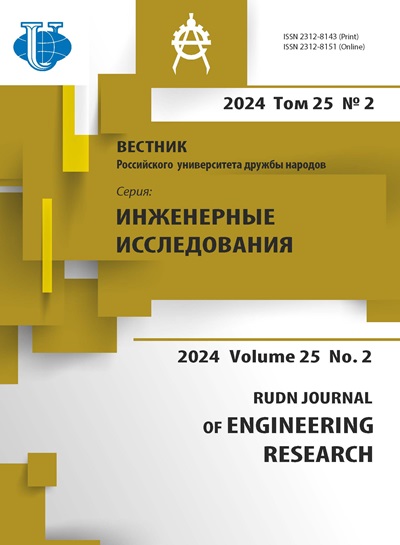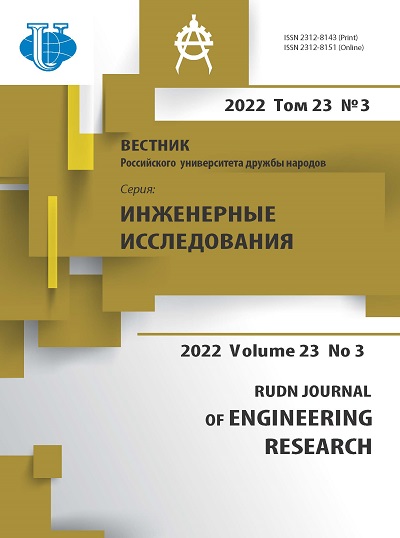Феноменологическая модель интенсивности, продолжительности и частоты выпадения осадков для бассейна реки Портовьехо, Эквадор
- Авторы: Мендоза Алава Д.О.1, Замбрано Ксавье Орасио В.1, Мендоза Седеньо Х.Д.1, Синиченко Е.К.2, Грицук И.И.2,3,4
-
Учреждения:
- Технический университет Манаби
- Российский университет дружбы народов
- Институт водных проблем, Российская академия наук
- Московский автомобильно-дорожный государственный технический университет
- Выпуск: Том 23, № 3 (2022)
- Страницы: 246-253
- Раздел: Статьи
- URL: https://journals.rudn.ru/engineering-researches/article/view/33080
- DOI: https://doi.org/10.22363/2312-8143-2022-23-3-246-253
Цитировать
Полный текст
Аннотация
Феноменологические модели представляют поведение случайных явлений в реальности, модель и функцию, которую она должна выполнять. Аналогичным образом параметры настройки позволяют оценить соответствие наблюдаемых данных переменной конкретной математической модели и проверить достоверность модели для представления реального события. Эти модели, применяемые в точных науках и науках о Земле, анализируют поведение сложных переменных, которые изменяются в пространстве и времени и являются объектом специального анализа. Настоящая работа содержит статистический и вероятностный анализ моделей осадков, выпавших в бассейне реки Портовьехо за полувековой период. В результате и в связи с новизной исследования получена новая модель кривых интенсивности, продолжительности и частоты для наиболее важных метеорологических станций вышеупомянутого бассейна, таких как Портовьехо-УТМ и Лодана. Для расчета использовались данные, предоставленные Национальным институтом метеорологии и гидрологии Эквадора (INAMHI), государственным агентством страны по сбору и планированию метеорологических данных. Расчеты проводились отдельно для каждой станций. С помощью полученных уравнений выполнен анализ результатов, позволивший вывести другие уравнения интенсивности, используемые в дальнейшем при анализе стока для промежуточных зон между двумя станциями, рассмотренными в исследовании.
Об авторах
Джуниор Орландо Мендоза Алава
Технический университет Манаби
Email: jmendoza7865@utm.edu.ec
ORCID iD: 0000-0002-0395-6927
магистр, помощник профессора, факультет строительства
Республика Эквадор, 130105, Портовьехо, ул. Урбина-и-Че-ГевараВаленсия Замбрано Ксавье Орасио
Технический университет Манаби
Email: xaviervalenciazambrano@gmail.com
ORCID iD: 0000-0002-1948-1161
магистр, инженер, факультет естественных наук, математики, физики и химии
Республика Эквадор, 130105, Портовьехо, ул. Урбина-и-Че-ГевараХорхе Джонни Мендоза Седеньо
Технический университет Манаби
Email: jmendoza7865@utm.edu.ec
ORCID iD: 0000-0002-0567-451X
магистр, помощник профессора, факультет строительства
Республика Эквадор, 130105, Портовьехо, ул. Урбина-и-Че-ГевараЕвгений Константинович Синиченко
Российский университет дружбы народов
Автор, ответственный за переписку.
Email: sinichenko-ek@rudn.ru
ORCID iD: 0000-0002-9159-1218
кандидат технических наук, доцент департамента строительства, Инженерная академия
Российская Федерация, 117198, Москва, ул. Миклухо-Маклая, д. 6Илья Игоревич Грицук
Российский университет дружбы народов; Институт водных проблем, Российская академия наук; Московский автомобильно-дорожный государственный технический университет
Email: gritsuk-ii@rudn.ru
ORCID iD: 0000-0002-5671-7620
кандидат технических наук, доцент департамента строительства, Инженерная академия, Российский университет дружбы народов; старший научный сотрудник, лаборатория динамики русловых потоков и ледотермики, Институт водных проблем, Российская академия наук; доцент кафедры гидравлики, Московский автомобильно-дорожный государственный технический университет
Российская Федерация, 117198, Москва, ул. Миклухо-Маклая, д. 6; Российская Федерация, 119333, Москва, ул. Губкина, д. 3; Российская Федерация, 125319, Москва, Ленинградский пр-кт, д. 64Список литературы
- Campos AF, Sinichenko EK. Características de sistemas fluviales pequeños y recursos hídricos de la demarcación hidrográfica de Manabí, perspectivas de desarrollo, 2017. Moscow; 2017.
- Campos Cedeno AF, Mendoza Alava JO, Sinichenko EK, Gritsuk II. Influence of the El Niño phenomena on the climate change of the Ecuadorian coast. RUDN Journal of Engineering Researches. 2018;19(4): 513-523. https://doi.org/10.22363/2312-8143-2018-19-4513-523
- Chow VT, Maidment DR, Mays LW. Hidrología aplicada (ME Suarez, ed.). Bogotá; 1994. Available from https://docer.com.ar/doc/ssx0c8 (accessed: 25.02.2022).
- Campos AF, Sinichenko EK, Gritsuk II. Hidráulica e hidrología para ingeniería. Moscow: RUDN University; 2016.
- Sinichenko EK. The forecast of changes in hydrological characteristics of small rivers under anthropogenic impact. Gidrotehniceskoe Stroitelʹstvo. 1997;(4):24.
- Sinichenko EK. Zone changes and generalized characteristics of the water regime of small rivers ETP. Journal of Engineering Research. 2005;(1):89-93. (In Russ.) Синиченко Е.К. Зональные изменения основных и обобщенных характеристик водного режима малых рек ETP // Вестник Российского университета дружбы народов. Серия: Инженерные исследования. 2005. № 1. С. 89-93.
- Ling L, Yusop Z. The collective visual representation of Rainfall - Runoff difference model. Cham: Springer International; 2015. https://doi.org/10.1007/978-3319-25939-0_24
- Zhurkin IG, Shaytura SV. Geographic information system. Moscow: Kudits Press; 2009. (In Russ.) Журкин И.Г., Шайтура С.В. Геоинформационные системы. М.: КУДИЦ-ПРЕСС, 2009. 272 с.
- Golian S, Saghafian B, Maknoon R, Elmi M. Probabilistic rainfall thresholds for flood forecasting: evaluating different methodologies for modelling rainfall spatial correlation. Hydrological Processes. 2011;25(13): 2046-2055. https://doi.org/10.1002/hyp.7956
- Campos Cedeno AF, Mendoza Cedeno JJ, Sinichenko EK, Gritsuk II, Gritsuk AI. Evaluation of the potential water erosion of the Jama river basin for management and control purposes. AIP Conference Proceedings. 2022;2559. https://doi.org/10.1063/5.0100219
- Chereque M. Hidrología para estudiantes de ingeniería civil (2a ed.). Pontica Universidad Católica del Perú; 1989. Available from: http://repositorio.pucp.edu.pe/index/bitstream/handle/123 456789/28689/hidrologia.pdf (accessed: 25.02.2022).
- Krochin S. Diseño hidráulico. Ecuador: Editorial Universitaria; 1986. Available from: https://pdfslide.net/documents/diseno-hidraulico-skrochin.html?page=1 (accessed: 25.02.2022).
- Zambrano XHV, Campos Cedeno AF, Mendoza Alava JO, Mendoza Cedeno JJ, Sinichenko EK, Gritsuk II. Mathematical model to determine the runoff coefficient based on precipitation and curve number data, in the Manabi hydrographic demarcation, Ecuador. Journal of Physics: Conference Series. 2020;1687. https://doi.org/10.1088/17426596/1687/1/012036
- Campos Cedeno AF, Valencia Zambrano XH, Cevallos Castro CA, Sinichenko EK, Gritsuk II. Water supply and demand of the hydrographic demarcation of Manabi, Ecuador. IOP Conference Series: Materials Science and Engineering. 2019;675. https://doi.org/10.1088/1757899X/675/1/012021















